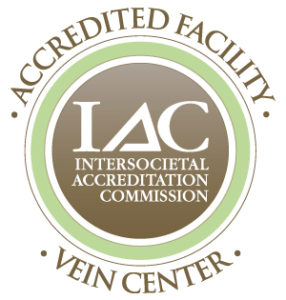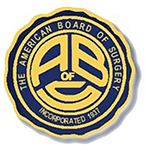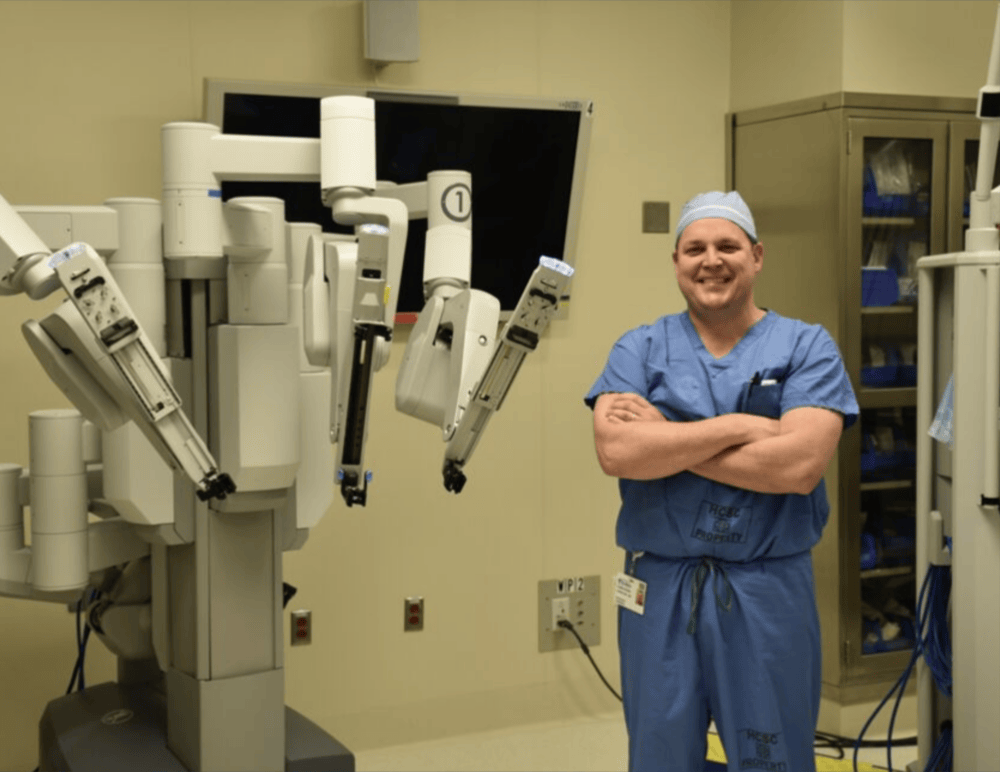
Vein Treatments
Visible varicose and spider veins are more than a cosmetic concern—they’re often signs of vein disease.
- Treatment is quick
- Minimally invasive
- Covered by most insurance plans
Radiofrequency Ablation (ClosureFast TM)
Radiofrequency ablation involves utilizing a treatment device inserted into a diseased vein under ultrasound guidance via a small skin incision.
This device administers heat to the vein wall, inducing its shrinkage and closure.
Following the closure of the diseased vein, blood is redirected to other healthy veins. A notable advantage of radiofrequency ablation is its minimally invasive nature, allowing for outpatient treatment with a swift return to normal activities on the same day.
Venous reflux disease – which leads to:
- The procedure takes about 20-40 minutes.
- The procedure is almost always a permanent fix for the diseased veins being treated.
- The number of treatments needed depends on the severity and number of veins that are diseased.
- Patients get relief/improvement of symptoms after 2 days
- This is a permanent fix to diseased refluxing veins in the legs
- Proven long term results with positive patient outcomes and experience
- Rapid recovery with patients resuming normal activities within a few days
What Does It Treat?
Venous reflux disease – which leads to:
How Long Does It Take?
- The procedure takes about 20-40 minutes.
- The procedure is almost always a permanent fix for the diseased veins being treated.
- The number of treatments needed depends on the severity and number of veins that are diseased.
Benefits
- Patients get relief/improvement of symptoms after 2 days
- This is a permanent fix to diseased refluxing veins in the legs
- Proven long term results with positive patient outcomes and experience
- Rapid recovery with patients resuming normal activities within a few days
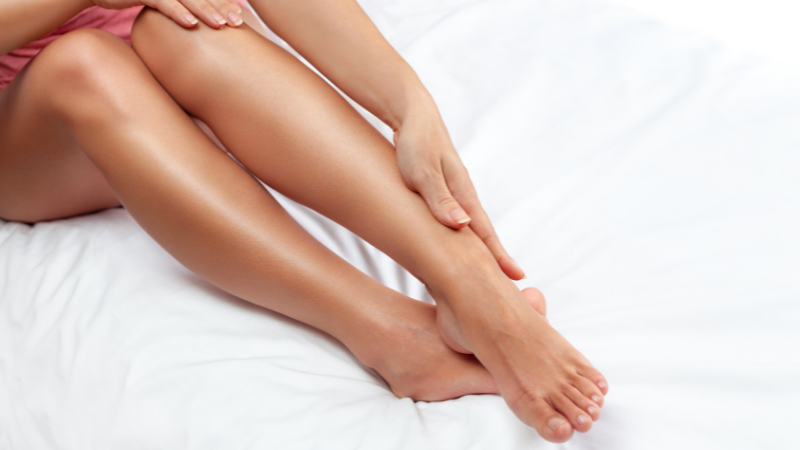
Sclerotherapy
Sclerotherapy, a non-surgical method, involves injecting medication into veins to make them stick together and redirect blood flow. Effective for spider veins and larger varicose veins, it can be enhanced with Ultrasound-Guided Sclerotherapy for better results.
As simple office procedures, both options are easily accessible and can be arranged as needed for comprehensive vein treatment.
- The procedure typically takes about 15–30 minutes, depending on the number of veins being treated.
- Multiple treatment sessions may be required for optimal results, especially for larger or more widespread veins.
- While spider veins often respond after just a few treatments, varicose veins may need follow-up sessions for complete resolution.
- Normal daily activities can usually be resumed immediately after the procedure.
- Effective treatment for both spider veins and varicose veins
- Minimally invasive with no need for surgery or anesthesia
- Quick recovery — patients can walk immediately and return to normal activities the same day
- Improves both cosmetic appearance and symptoms such as aching or swelling
- Can be repeated as needed for long-term vein health and optimal results
What Does It Treat?
Venous reflux disease – which leads to:
Sclerotherapy, a non-surgical method, involves injecting medication into veins to make them stick together and redirect blood flow. Effective for spider veins and larger varicose veins, it can be enhanced with Ultrasound-Guided Sclerotherapy for better results.
As simple office procedures, both options are easily accessible and can be arranged as needed for comprehensive vein treatment.
How Long Does It Take?
- The procedure typically takes about 15–30 minutes, depending on the number of veins being treated.
- Multiple treatment sessions may be required for optimal results, especially for larger or more widespread veins.
- While spider veins often respond after just a few treatments, varicose veins may need follow-up sessions for complete resolution.
- Normal daily activities can usually be resumed immediately after the procedure.
Benefits
- Effective treatment for both spider veins and varicose veins
- Minimally invasive with no need for surgery or anesthesia
- Quick recovery — patients can walk immediately and return to normal activities the same day
- Improves both cosmetic appearance and symptoms such as aching or swelling
- Can be repeated as needed for long-term vein health and optimal results
VenaSeal™ Closure System
VenaSeal™, a form of non-thermal ablation, involves administering a medical adhesive directly into a compromised vein to effectively seal it.
Utilizing ultrasound guidance, the device is carefully introduced into the affected vein. Once the adhesive is applied, the diseased vein is promptly sealed off, prompting blood flow redirection towards healthier veins.
What Does It Treat?
How Long Does It Take?
- The procedure typically takes about 30–45 minutes per vein.
- Unlike thermal ablation, VenaSeal™ does not require tumescent anesthesia or multiple needle sticks.
- Most patients experience relief of symptoms within days of treatment.
- Patients are able to walk immediately and resume normal activities right away.
Benefits
- Minimally invasive and virtually painless procedure
- No need for compression stockings after most treatments
- Rapid recovery with patients resuming daily activities immediately
- Long-lasting results with high closure rates of diseased veins
- Improves both symptoms and cosmetic appearance without thermal energy
VenaSeal™ is especially effective for treating venous reflux disease by sealing diseased veins with a medical adhesive, allowing blood to reroute naturally to healthier veins.
- The procedure typically takes about 30–45 minutes per vein.
- Unlike thermal ablation, VenaSeal™ does not require tumescent anesthesia or multiple needle sticks.
- Most patients experience relief of symptoms within days of treatment.
- Patients are able to walk immediately and resume normal activities right away.
- Minimally invasive and virtually painless procedure
- No need for compression stockings after most treatments
- Rapid recovery with patients resuming daily activities immediately
- Long-lasting results with high closure rates of diseased veins
- Improves both symptoms and cosmetic appearance without thermal energy
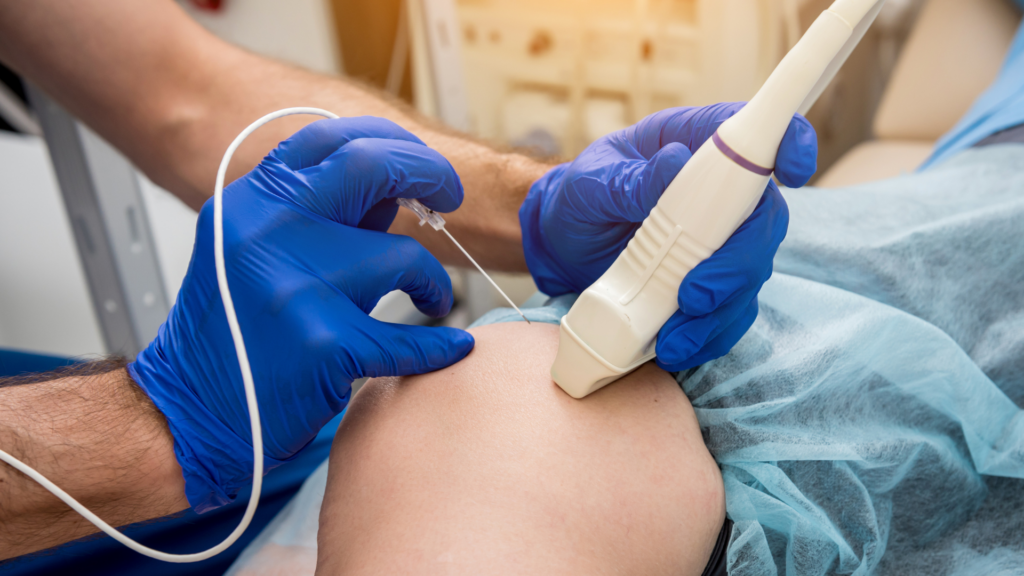
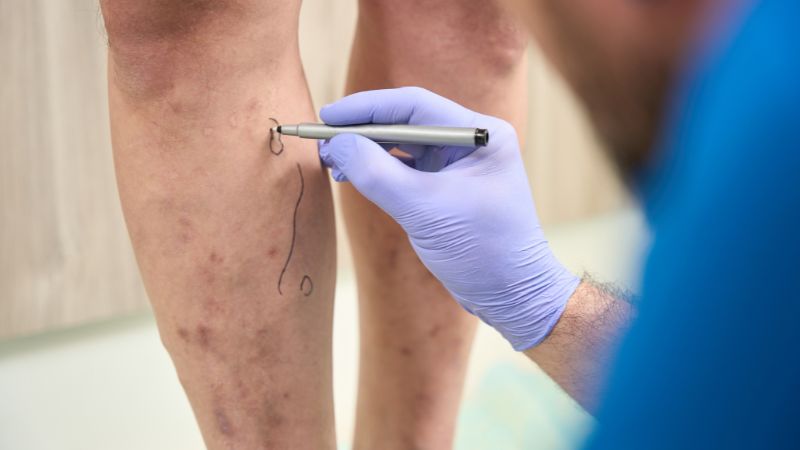
Microphlebectomy
Microphlebectomy is a minimally invasive procedure used to treat varicose veins that are too large to treat with sclerotherapy and too small for laser ablation.
Microphlebectomy is performed under local anesthesia in your doctor’s office. A series of small incisions, 2-3mm, are made after a dilute local anesthesia solution is injected into the area. A fine instrument is inserted through the small opening to grasp the vein. The varicosity is teased from the surrounding tissues and removed. No sutures are needed for the tiny incisions.
- The procedure generally takes 30–60 minutes, depending on the number and size of veins removed.
- Performed under local anesthesia with tiny micro-incisions that do not require stitches.
- Patients are able to walk immediately after treatment.
- Normal activities can typically be resumed within 24 hours, with minimal downtime.
- Direct removal of bulging varicose veins for immediate results
- Minimally invasive with micro-incisions that usually leave no scars
- Relieves symptoms such as aching, heaviness, and swelling
- Provides both cosmetic and functional improvements
- Often combined with other treatments for comprehensive vein care
What Does It Treat?
Venous reflux disease – which leads to:
Sclerotherapy, a non-surgical method, involves injecting medication into veins to make them stick together and redirect blood flow. Effective for spider veins and larger varicose veins, it can be enhanced with Ultrasound-Guided Sclerotherapy for better results.
As simple office procedures, both options are easily accessible and can be arranged as needed for comprehensive vein treatment.
How Long Does It Take?
- The procedure generally takes 30–60 minutes, depending on the number and size of veins removed.
- Performed under local anesthesia with tiny micro-incisions that do not require stitches.
- Patients are able to walk immediately after treatment.
- Normal activities can typically be resumed within 24 hours, with minimal downtime.
Benefits
- Direct removal of bulging varicose veins for immediate results
- Minimally invasive with micro-incisions that usually leave no scars
- Relieves symptoms such as aching, heaviness, and swelling
- Provides both cosmetic and functional improvements
- Often combined with other treatments for comprehensive vein care
Pro-Nox™
We typically use Pro-Nox™ for a number of our procedures, such as in-office surgeries, vein treatments, and laser treatments. It is appropriate for virtually any procedure that patients may find painful.
Studies have shown that Pro-Nox™ is an effective and non-addictive option for superior comfort during these procedures. Surgeries usually require some form of topical or injected numbing product, Valium, and/or Vicodin. With Pro-Nox™, the procedure itself becomes much more comfortable for the patient, and the provider does not need to stop to relieve patient discomfort. It sometimes eliminates the need for injection numbing, which may cause more downtime if bruising occurs.
What Does It Treat?
Pro-Nox™ is not a vein treatment itself but is used to improve patient comfort during a wide range of procedures, including:
- In-office vein treatments such as sclerotherapy, microphlebectomy, and ablation
- Minimally invasive procedures that may cause temporary discomfort
- Laser treatments and minor surgical procedures
How Long Does It Take?
- Pro-Nox™ takes effect within seconds of inhalation.
- It is used only during the procedure and wears off within 5–10 minutes after stopping.
- Patients remain fully awake and alert throughout treatment.
- No recovery time is needed, and patients can safely drive themselves home after their appointment.
Benefits
- Fast-acting pain and anxiety relief during procedures
- Safe, non-addictive, and self-administered by the patient
- No lingering effects — patients return to normal immediately after use
- Often reduces or eliminates the need for numbing injections or sedative medications
- Makes vein treatments, laser therapies, and minor surgeries more comfortable and stress-free
Pro-Nox™ is not a vein treatment itself but is used to improve patient comfort during a wide range of procedures, including:
- In-office vein treatments such as sclerotherapy, microphlebectomy, and ablation
- Minimally invasive procedures that may cause temporary discomfort
- Laser treatments and minor surgical procedures
- Pro-Nox™ takes effect within seconds of inhalation.
- It is used only during the procedure and wears off within 5–10 minutes after stopping.
- Patients remain fully awake and alert throughout treatment.
- No recovery time is needed, and patients can safely drive themselves home after their appointment.
- Fast-acting pain and anxiety relief during procedures
- Safe, non-addictive, and self-administered by the patient
- No lingering effects — patients return to normal immediately after use
- Often reduces or eliminates the need for numbing injections or sedative medications
- Makes vein treatments, laser therapies, and minor surgeries more comfortable and stress-free
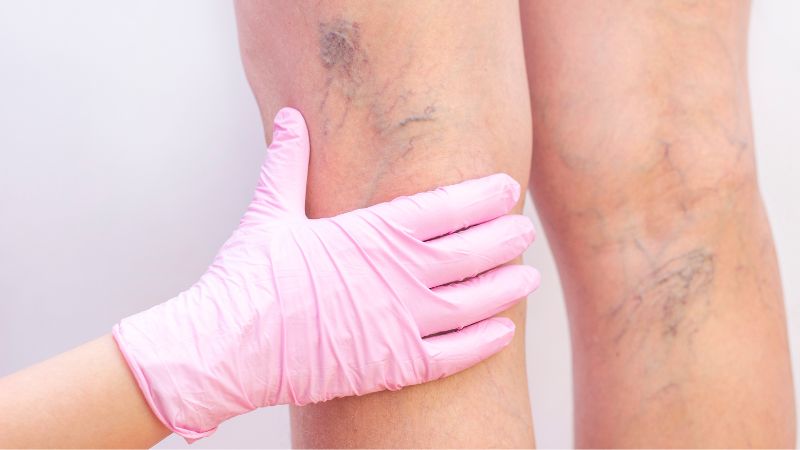
Varithena Ablation
Effective at treating veins of different sizes above and below the knee. Requires no incisions, sedation or general anesthesia. Do not require a wire to be inserted along the length of the vein. Is administered in as little as one or two needle sticks per treatment, instead of 10-14. Does not heat, eliminating the risl of thermal injury. Does not use glue and dissolves in the bloodstream after treatment, leaving no foreign bodies in the vein. Varithena requires very little downtime for the patient.
Varithena is used to treat venous reflux disease, which can cause:
- Leg or ankle swelling
- Leg pain and aching
- Leg cramps
- Restless leg
- Leg heaviness or fatigue
- Burning or itching skin
- Skin changes or rash
Venous reflux disease is progressive and, if left untreated, may develop into chronic venous insufficiency (CVI), a more severe condition that can lead to skin ulcers, permanent skin damage, and an increased risk of deep vein thrombosis (DVT).
- The procedure typically takes 30 minutes or less.
- Most patients experience symptom relief within a few days.
- Minimally invasive – No incisions or heat-based energy required
- Quick symptom relief – Many patients notice improvement within a few days
- Effective for multiple vein types – Treats large, tortuous, and previously untreated veins
- Rapid recovery – Patients can resume normal activities within a day or two
- Proven long-term results – Clinically tested with high success rates
What Does It Treat?
Varithena is used to treat venous reflux disease, which can cause:
- Leg or ankle swelling
- Leg pain and aching
- Leg cramps
- Restless leg
- Leg heaviness or fatigue
- Burning or itching skin
- Skin changes or rash
Venous reflux disease is progressive and, if left untreated, may develop into chronic venous insufficiency (CVI), a more severe condition that can lead to skin ulcers, permanent skin damage, and an increased risk of deep vein thrombosis (DVT).
How Long Does It Take?
- The procedure typically takes 30 minutes or less.
- Most patients experience symptom relief within a few days.
Benefits
- Minimally invasive – No incisions or heat-based energy required
- Quick symptom relief – Many patients notice improvement within a few days
- Effective for multiple vein types – Treats large, tortuous, and previously untreated veins
- Rapid recovery – Patients can resume normal activities within a day or two
- Proven long-term results – Clinically tested with high success rates
Why Start Vein Treatment Now?
- Untreated vein disease can lead to serious complications like ulcers or blood clots.
- Early treatment not only alleviates discomfort but also prevents further issues.
- Most patients notice a significant improvement within a week!
FAQs
Varicose veins are caused by blood going the wrong way into veins that are just under the skin. By inserting a small laser into the abnormal vein, we can stop this backward flow of blood and redirect it into the healthy veins. This cuts the blood flow to the abnormal veins, and they shrivel up and disappear.
Venous reflux disease – which leads to Leg or ankle swelling, Leg Pain and Aching, Leg Cramps, Restless leg, Leg heaviness or fatigue, Burning or Itching skin, Skin Changes or Rash
Venous reflux disease is a progressive medical condition that if left untreated, will likely worsen over time and develop into a more serious form of venous disease called chronic venous insufficiency (CVI). CVI leads to more serious outcomes such as poor healing wounds, permanent skin damage, and an increased risk of deep blood clot.
- Patients get relief/improvement of symptoms after 2 days
- This is a permanent fix to diseased refluxing veins in the legs
- Proven long term results with positive patient outcomes and experience
- Rapid recovery with patients resuming normal activities within a few days
- The procedure takes about 20-40 minutes.
- The procedure is almost always a permanent fix for the diseased veins being treated.
- The number of treatments needed depends on the severity and number of veins that are diseased.
Varicose Veins, Spider Veins, Leg or ankle swelling, Leg Pain and Aching, Leg Cramps, Restless leg, Leg heaviness or fatigue, Burning or Itching skin, Skin Changes or Rash.
- The procedure takes about 20-40 minutes in most cases.
- The procedure is good at closing down small varicose veins and spider veins.
- Most people will need 1-2 treatments with compounded sclerotherapy depending on the severity and number of their varicose veins.
- Resolution of the varicose veins treated.
- Proven track record with years of solid research behind it
- Improvement/resolution of unwanted pain, aching, pressure, swelling, and other associated symptoms.
- Improved cosmetic appearance of varicose and spider veins.
Board Certified Surgeon and Vein Specialist
